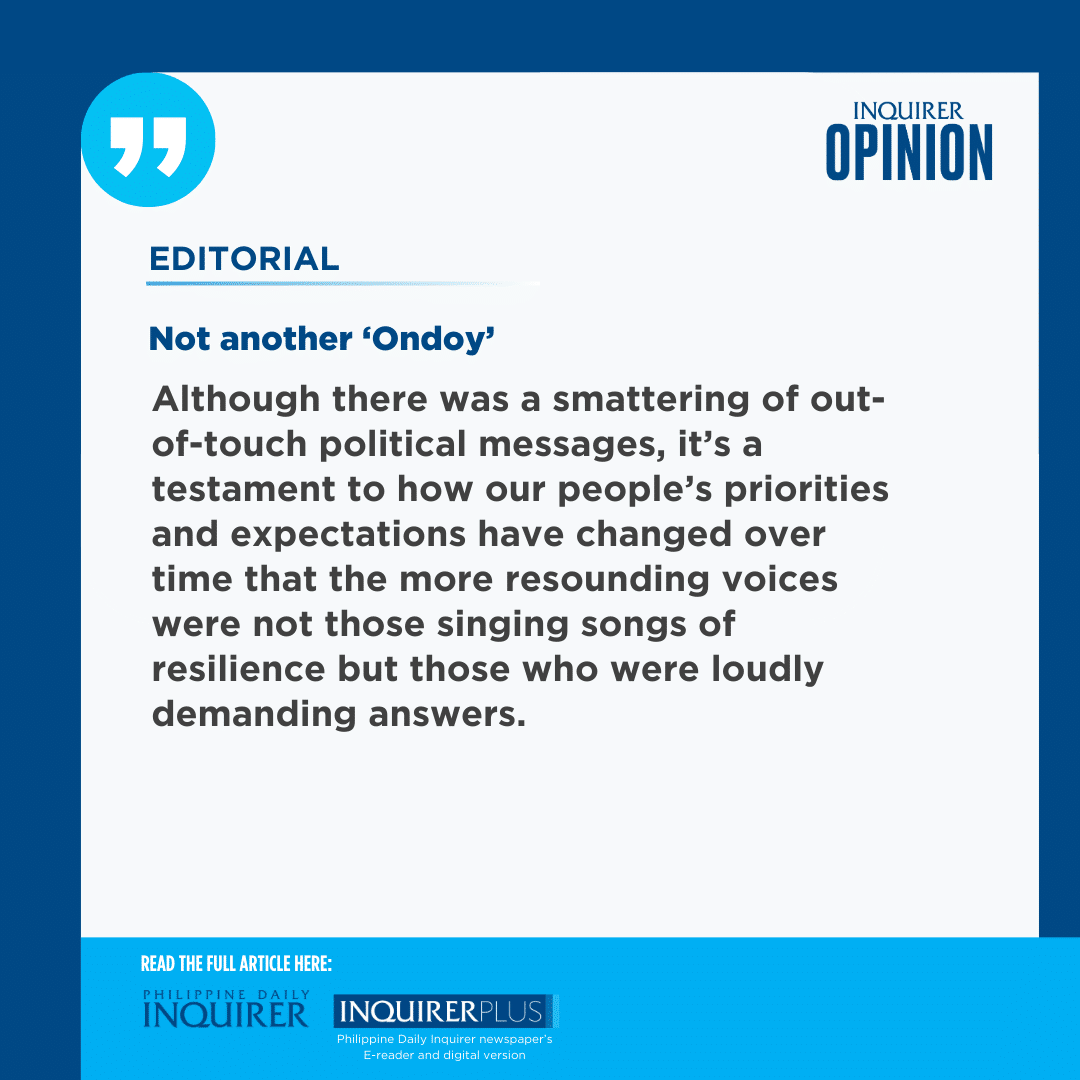Once a customary part of any politician’s post-calamity playbook, odes to Filipino resilience have lost favor with the public, as citizens realized that such platitudes were being used as a smokescreen for officials’ ineptitude at disaster management.
Worse yet is the realization that this smiling-through-your-pain characteristic has been romanticized for too long to disguise the lack of accountability for the death and destruction that routinely result from the failings of the government.
In short, the one lesson Filipinos have learned after a multitude of typhoons and other catastrophes isn’t that we can rise above adversity by relying on our natural gifts and ingenuity, but that we needn’t depend on ourselves and our neighbors to survive — if we push our leaders to do their jobs.
Nowhere was this paradigm shift more pronounced than during last week’s devastation from nonstop monsoon rains enhanced by Supertyphoon Carina (international name: Gaemi), which drew recollections of Tropical Storm Ondoy (Ketsana) of 2009.
Voices demanding answers
Although there was a smattering of out-of-touch political messages, it’s a testament to how our people’s priorities and expectations have changed over time that the more resounding voices were not those singing songs of resilience but those who were loudly demanding answers.
Among the queries that resonated: What happened to the 5,500 newly completed flood-control projects that President Marcos bragged about during his third State of the Nation Address (Sona)?
Addressing that question, Mr. Marcos said: “We have to relook; we have to reexamine some of the designs of our flood control measures.” The President noted that rains dumped by Carina and the southwest monsoon were “not as bad as Ondoy, but the effect was greater than Ondoy.”
“And yet we have more flood control projects now,” he lamented.
Mr. Marcos blamed other factors that exacerbated flooding, from climate change to improper garbage disposal. “We have so many pumping stations yet some encountered problems in pumping flood water. I hope people will learn this time,” he said.
Another question raised by lawmakers and environmentalists: To what extent did the reclamation projects around Manila Bay worsen flooding in the capital? Senators Juan Miguel Zubiri, Joel Villanueva, and JV Ejercito pointed to the coastal works as the likely culprit for the unusual flooding near the Senate headquarters in Pasay City.
P1 billion-a-day budget
In August 2023, Mr. Marcos ordered the suspension of 22 bay reclamation projects, inspiring optimism that the government would put a stop to the potentially destructive ventures. But those hopes were dashed three months later when the Department of Environment and Natural Resources announced that two projects had passed its review, prompting the Philippine Reclamation Authority (PRA) to approve the resumption of building activities. Then in February, the PRA reported plans to proceed with two more projects.
On Thursday, the Pasay local government claimed that the flooding did not result from its coastal development project but “truckloads of garbage, as well as fallen branches and leaves” that obstructed the city’s drainage systems.
But Jonila Castro of Kalikasan People’s Network for the Environment insisted that the intense flooding was a “direct result” of reclamation. “And now, only two days after President Marcos’ Sona where he proudly committed himself as a climate champion, all his empty promises are literally drowning homes and families around Manila Bay,” she said.
Villanueva raised another interesting point, this time, zeroing in on infrastructure failure: “Imagine,” he said, “for the past two years — including this year — we have a P1-billion-a-day flood control budget for DPWH (Department of Public Works and Highways) alone — P1 billion a day! Please tell me if anyone here can see at least an improvement in addressing floods.”
Nowhere close to Ondoy
To be clear, the recent deluge in Metro Manila came nowhere close to the impact of Ondoy 15 years ago in terms of death and damage. Ondoy affected 4.9 million people and claimed 464 lives, but its effects were felt long after the last body had been buried. Residents of the worst-hit Marikina City described the devastation as something like “the end of the world.”
By comparison, around 11 fatalities were reported in Metro Manila and 34 overall in Carina’s aftermath, per the latest police count, despite more areas being inundated. It would be dishonest, then, to say the government and the public didn’t learn from Ondoy.
Without a doubt, we have.
But the people’s standards for disaster mitigation have changed dramatically as well. Now, we expect better leadership from the government in protecting communities from harm, and we demand more accountability from erring or negligent officials. Experience has taught us that to prevent another Ondoy, we must stop letting the government rely on our people’s resilience.
